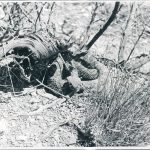Our series examining an Image of the Week from the photographic files, by Kevin Warstadt, Digital Program Specialist.
The above image comes from a folder entitled “Equestrian Team.” The Dartmouth Equestrian Team finished the ’17 Fall season in 1st place in the IHSA Zone I, Region 2 standings, out of 10 teams and 30 points ahead of the next highest school.
The domesticated horse is a species of odd-toed ungulate, classified Equus ferus caballus. It was likely domesticated around 3500 BC in Central Asia, later than most other domesticated animals. Since that time, horses have been used for transportation, as work animals, and in warfare.
There is a long history of the horse in sport, with horse racing appearing in the Greek Olympic Games of 664 B.C. and evidence suggesting the practice goes back much further. Dressage, or early forms of it, may be traced back to the writing of Xenophon, but show jumping is a relatively new sport that did not come into prominence until the nineteenth century. Though the automobile has largely replaced the horse as a means of transportation, horse racing and other equestrian sports remain popular in the U.S. and around the world.
For more images of horses go to the Dartmouth Photographic Files.
International Commission on Zoological Nomenclature (2003). “Usage of 17 specific names based on wild species which are pre-dated by or contemporary with those based on domestic animals (Lepidoptera, Osteichthyes, Mammalia): conserved. Opinion 2027 (Case 3010)”. Bull. Zool. Nomencl. 60 (1): 81–84. Archived from the original on 2007-08-21.
https://www.libraryindex.com/pages/2186/Animals-in-Sports-ROOTS-ANIMAL-SPORTS.html
http://www.chronofhorse.com/article/xenophon-forefather-dressage


